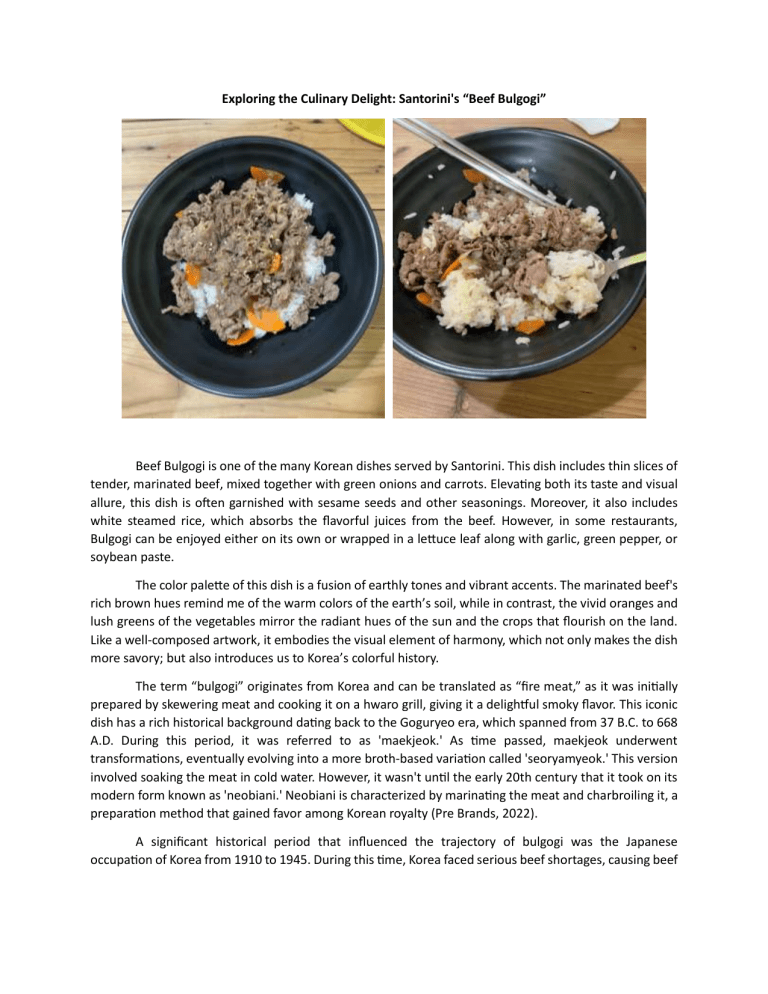Exploring the Culinary Delight using 4 planes of analysis
advertisement

Exploring the Culinary Delight: Santorini's “Beef Bulgogi” Beef Bulgogi is one of the many Korean dishes served by Santorini. This dish includes thin slices of tender, marinated beef, mixed together with green onions and carrots. Elevating both its taste and visual allure, this dish is often garnished with sesame seeds and other seasonings. Moreover, it also includes white steamed rice, which absorbs the flavorful juices from the beef. However, in some restaurants, Bulgogi can be enjoyed either on its own or wrapped in a lettuce leaf along with garlic, green pepper, or soybean paste. The color palette of this dish is a fusion of earthly tones and vibrant accents. The marinated beef's rich brown hues remind me of the warm colors of the earth’s soil, while in contrast, the vivid oranges and lush greens of the vegetables mirror the radiant hues of the sun and the crops that flourish on the land. Like a well-composed artwork, it embodies the visual element of harmony, which not only makes the dish more savory; but also introduces us to Korea’s colorful history. The term “bulgogi” originates from Korea and can be translated as “fire meat,” as it was initially prepared by skewering meat and cooking it on a hwaro grill, giving it a delightful smoky flavor. This iconic dish has a rich historical background dating back to the Goguryeo era, which spanned from 37 B.C. to 668 A.D. During this period, it was referred to as 'maekjeok.' As time passed, maekjeok underwent transformations, eventually evolving into a more broth-based variation called 'seoryamyeok.' This version involved soaking the meat in cold water. However, it wasn't until the early 20th century that it took on its modern form known as 'neobiani.' Neobiani is characterized by marinating the meat and charbroiling it, a preparation method that gained favor among Korean royalty (Pre Brands, 2022). A significant historical period that influenced the trajectory of bulgogi was the Japanese occupation of Korea from 1910 to 1945. During this time, Korea faced serious beef shortages, causing beef prices to rise, and subsequently leading to a decline in the popularity of the dish. This caused bulgogi to become a less common delicacy during this period. However, as Korea entered the 1990s, bulgogi made a triumphant comeback. Today, it is celebrated as one of the most beloved and widespread dishes in Korea. Its history and enduring popularity may very well represent the proud characteristics of countries to thrive but still maintain their cultural identity. Like Korea, despite facing globalization and different food trends, Beef Bulgogi still remains a cherished part of their cuisine that is well-known internationally. Just like how the marinated beef symbolizes the earth’s soil, it also symbolizes the roots of Korean cuisine. Despite the passage of time, its culture persevered, much like the enduring brown soil that sustains life. Moreover, the vibrant orange and green colors of the vegetables may depict the dynamic nature of Korean cuisine. It shows how it has embraced new ingredients and techniques while maintaining its core essence. Overall, “Beef Bulgogi” is not simply a dish, but it serves as a symbol of Korea’s harmonious relationship between its past and present time. I would 100% recommend this dish to anyone who likes food with a traditional touch. The beef is soft and the vegetables and seasonings offer a delightful blend of flavors. Moreover, the portion of rice is adequate, ensuring a satisfying and filling meal. REFERENCES Pre Brands. (2022, August 25). History of Korean Bulgogi. https://www.eatpre.com/blogs/gather/historyof-koreanbulgogi#:~:text=Early%20History%20and%20Origins,it%20was%20initially%20called%20maekjeo k.



